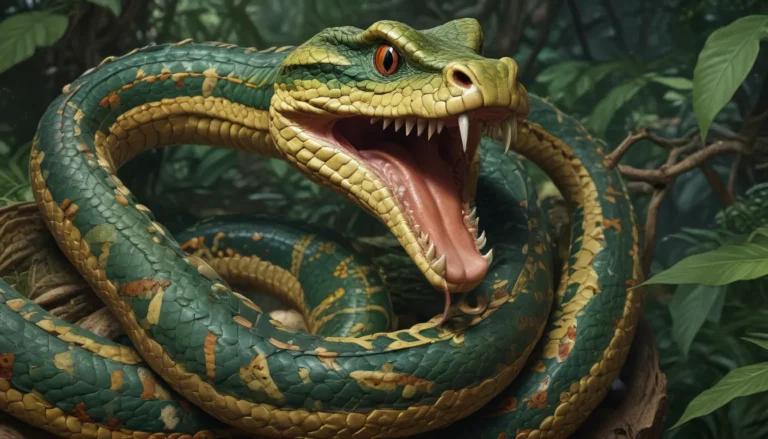The pictures we use in our articles might not show exactly what the words say. We choose these pictures to make you interested in reading more. The pictures work together with the words but don’t take their place. The words still tell you the important facts.
The Mexican Moccasin, scientifically known as Agkistrodon bilineatus, is a captivating snake species native to Mexico and parts of Central America. Belonging to the Viperidae family, which includes some of the world's most venomous snakes, the Mexican Moccasin, also known as the Cantil, stands out for its striking appearance and potent venom.
Unveiling the Mysteries of the Mexican Moccasin
Let's embark on a journey to uncover 11 astonishing facts about the Mexican Moccasin, shedding light on its habitat, physical attributes, behavior, and more. If you're eager to delve into the wonders of this remarkable reptile, let's dive in!
Understanding the Mexican Moccasin
- Venomous Nature: The Mexican Moccasin is a highly venomous snake endemic to Mexico and Central America, belonging to the pit viper family, which includes species like rattlesnakes and copperheads.
- Distinct Appearance: These snakes boast a sturdily built body covered in dark brown or black scales with prominent lighter-colored bands or blotches running vertically along their bodies.
- Skillful Swimmers: Despite being terrestrial creatures, Mexican Moccasins are proficient swimmers, often found near bodies of water such as streams, rivers, and swamps.
Embracing the Nature of the Mexican Moccasin
- Potent Venom: Mexican Moccasins possess hemotoxic venom that can cause severe tissue damage, bleeding, and even death if left untreated.
- Predatory Skills: Active hunters, these snakes prey on small mammals, amphibians, reptiles, and birds, employing ambush tactics to catch their quarry.
- Ecological Value: Mexican Moccasins play a vital role in maintaining ecological balance by controlling populations of rodents and small animals, thus preventing ecosystem imbalance.
Delving Deeper into the Mexican Moccasin’s World
- Medicinal Potential: While their venom is harmful, certain components have shown promise in developing medications for blood disorders and cardiovascular diseases.
- Versatile Habitat: Adaptable creatures, Mexican Moccasins can thrive in various environments, including forests, grasslands, marshes, and even agricultural areas.
- Mating Behaviors: During the mating season, male Mexican Moccasins exhibit aggression and engage in intense battles to secure mating rights with females.
Safeguarding the Future of the Mexican Moccasin
- Live Birth: Mexican Moccasins are ovoviviparous, giving birth to live young after a gestation period of 3-4 months.
- Conservation Concerns: Like many snake species, Mexican Moccasins face threats from habitat loss, illegal pet trade, and human activities, highlighting the need for conservation efforts.
Conclusion: Appreciating the Mexican Moccasin’s Wonder
In conclusion, the Mexican Moccasin stands as a captivating and unique snake species found in the southern regions of Mexico. Its defining characteristics, hunting strategies, and venomous traits captivate researchers and wildlife enthusiasts alike, showcasing the marvels of nature's diversity.
By exploring the facts surrounding the Mexican Moccasin, we gain a deeper reverence for the animal kingdom's richness and resilience. As you encounter these awe-inspiring creatures in the wild, remember to admire them from a safe distance, offering them the respect and caution they deserve.
FAQs
Q: Are Mexican Moccasins dangerous?
A: Yes, Mexican Moccasins are highly venomous snakes that pose a significant threat if provoked. Avoid close contact and seek immediate medical attention if bitten.
Q: What is the average size of a Mexican Moccasin?
A: Mexican Moccasins typically measure between 2 to 4 feet in length, with some individuals reaching up to 5 feet.
Q: Where can I find Mexican Moccasins?
A: Mexican Moccasins inhabit the southern regions of Mexico, particularly near bodies of water such as rivers, swamps, and lakes.
Q: What do Mexican Moccasins eat?
A: These carnivorous predators feed on small mammals, amphibians, fish, and birds, using their venom to immobilize their prey.
Q: Are Mexican Moccasins endangered?
A: While not currently listed as endangered, Mexican Moccasins face conservation challenges due to habitat loss and human activities.
Embark on a captivating exploration of the world of serpents, uncovering their remarkable adaptations and behaviors. Discover more about cold-blooded creatures, from scaly skin to unique traits, and delve into the intriguing realm of cobras with their spitting defense mechanisms and potent venom. Whether a nature enthusiast or curious observer, these articles promise to quench your thirst for knowledge and leave you in awe of our planet's extraordinary wildlife.






